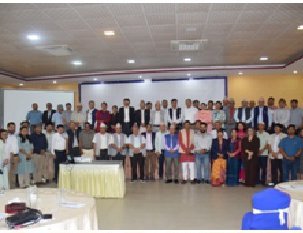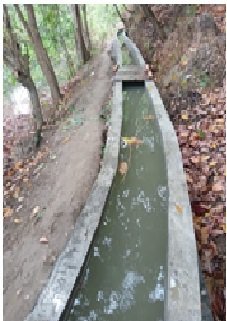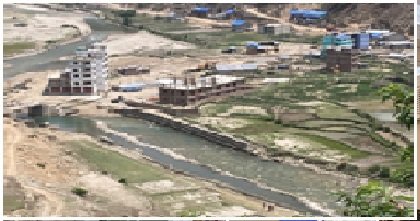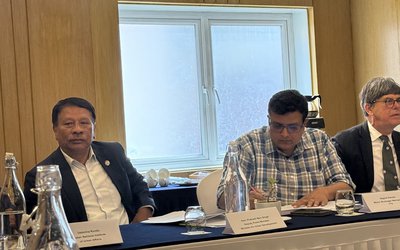
Essence of the National Framework on Local Adaptation Plan for Action (LAPA) - an operational instrument to localise climate change adaptation - has been internalised in the local planning process through local policies and programmes in programme areas of the Nepal Climate Change Support Programme (NCCSP) in the Karnali Province. Inaugurating the NCCSP2: Learning Reflection Workshop with Local Government (Palikas), held at Surkhet on 7-8 June 2024, Hon'ble Durg Bahadur Rawat, Minister for Industry, Tourism, Forests and Environment appreciated NCCSP (phase 1 & 2) efforts in preparing and implementing LAPAs to address the needs of the climate vulnerable poor people in several municipalities of the KarnaliProvince. Stating satisfaction on the outcomes of NCCSP2, Hon. Minister expressed his confidence and ownership over the LAPA process and his strong willingness to support in scaling-uppeople-centric adaptation interventions through LAPAs in theProvince and urged for expanding its coverage in other climate vulnerable Palikas and communities.
The Government of Nepal has implemented NCCSP2 in 42 Palikasof Karnali, Sudur Paschim and Lumbini Provinces (34 Palikas in Karnali Province) through 'on-budget, on-treasury approach' during 2019-2023with support from the UK Government and technical assistance of Mott MacDonald. Its first phase (2013-2017) was also funded by the UK Government and the European Union,and was implemented with technical support from UNDP. NCCSP2 supported to preparing long-term climate-resilient development plans, improving and making climate finance transparent in Palikas', and supporting the livelihoods of the climate vulnerable communities through adaptation services.
NCCSP2: Learning Reflection Workshop was attended by Mayors, Deputy Mayors, Chairs and Vice-Chairs of Palikas of the Karnali and Lumbini Provinces along with government officials and NCCSP staffs. NCCSP2 supported to formulate and implement 36 LAPAs, prepared 28 disaster maps, and 24 climate profiles taking note of 24 climate stations in the NCCSP areas. This Programme has also supported to develop, implement and monitor climate resilient plans and projects as per the local planning processes. NCCSP provided direct benefits to over 5 Laks climate vulnerable people, with over 50% women. This Programme has promoted joint-investment and contributed to internalising adaptation into local policies, plans, programmes and projects (4Ps). In theworkshop, policy, programme and legal initiatives of the provincial ministry on forests and environment, and stakeholder's roles and responsibilities on climate services were shared by the concerned senior government officers along with the progresses ofNCCSP's 4 clusters - Humla, Jumla, Bheriganga and Rukum.

Leaders of the Local Governments appreciated the support in internalising climate adaptation into local plans and projects and regretted the federal government in delaying the process and finally showing inability to channel additional grant support from the UK Government for adaptation interventions in the NCCSP areas. With the hope of additional funding, several Palikas prioritised adaptation interventions, conducted surveys, prepared detail plans, and even contracted for implementation in Palikas. Local executives face difficultiesin managing contracts due to lack of additional funds.
Works of NCCSP - the flagship adaptation programme of Nepal - was recognised under the Nairobi Work Programme (5 programmes selected out of 170 submissions) at Paris, France in 2015 during the adoption of the Paris Agreement on climate change. Its work was recorded as 'people's champion' and 'honourable mentions' on the global photo competition, organised by the Adaptation Fund Board in 2016.
In remote and climate vulnerable Karnali Province, NCCSP has been instrumental in localising adaptation options, mainstreaming climate change into local policies and plans, creating awareness, improving livelihoods through income-generating adaptation interventions, protecting water, land, forests and property from climate-induced disasters, and institutionalising a process of identifying, prioritising and implementing most urgent adaptation options. Local governmentsurged for additional support for the preparation and implementation of 'LAPAs, LAPAs, and LAPAs'.
Based on sharing of good practices in the workshop and observations of adaptation interventions on the way to Rara lake, NCCSP has contributed to meet its twin objectives of preparing and implementing standalone LAPAs and in integrating adaptation into local planning processes, as conceived in 2011. The following few examples convinced to realise the translation of a LAPA frameworkinto action:
1 In Humla district, the policy and programme (FY 2023/24) of the Kharpunath Rural Municipality commits to, inter alia, implement adaptation actions while that of Sarkegad Rural Municipality provisioned for climate-resilient growth, and enhance Palika's adaptive capacity and encourage low emission development pathway along with awareness raising activities on adaptation, and implementation of LAPA-centric prioritised plans. The budget and programme (FY 2023/24) of the Simkot Rural Municipality has prioritised for mitigation of climate change impacts.
2 In addition to the implementation of location-specific LAPAs, the Chandannath Municipality in Jumla has issued a Procedure in 2023 to green the infrastructure projects. The Procedure approved by the Executive Council of the Municipality and prepared with support from NCCSP ensures plantation in infrastructure projects by allocating 10 percent of the total cost of each infrastructure scheme for plantation and monitoring. The Procedure provisions to provide 60 percent of the total plantation cost to the User Committee to enhance community ownership in advance and remaining 40 percent after monitoring and ensuring minimum survival of 50 percent of planted species.This nature-based approach is expected to enhance aesthetic and environmental services, social and economic benefits, reduce infrastructure-induced disasters, move towards sustaining the community and public infrastructures, and make the municipality green and healthy. The Procedure prohibits to use this cost for environment conservation to other purposes and provides list of species for plantation in and around the infrastructure site(s).
3 In a move towards promoting natures-based solutions and plantation of income-generating species, NCCSP support for Samaj Bikash Multipurpose PhalphulBiruwa Nursery, operated by a cooperative, at Khadachakra-6, Kalikot deserves 'special mention'as it is providing saplings of walnut, peeper, lemon, orange, guava and devdar etc. to address climate vulnerability, reduce risks through vegetative methods, and generate income of a cooperative and people planting fruit species.
4 The Bheriganga Cluster has linked its adaptation interventions with income-generating activities by providing irrigation facilities, supplying drinking water, rainwater harvesting, and reducing climate-induced disasters by supporting for stream/riverbank protection through embankments. It urges Palikas to continue mobilisation of necessary budget for climate adaptation activities in the years to come.

5 The Rukum Cluster considers water source conservation and managementa direct benefit to local people which ensures continued supply of drinking water, helps to operate number of water mills, provides irrigation facilities to increase agriculture production, and improves livelihoods of the climate vulnerable communities. NCCSP initiatives in enhancing understanding and supporting to prepare and implement people-centric LAPAs has contributed to internalise climate change into local policies and programmes. For example, the Gadhawa Rural Municipality, in its 2023 policy and programme, committed to manage and make the activities effective related to disaster preparedness, reduction, response and rehabilitation by preparing disaster risk reduction and management, and climate-resilient plans. In 2023, the Banphikot Rural Municipality committed to prepare and implement climate adaptation plan (LAPA). The policy and programme of the Bagchour Municipality (FY 2023/24) planned to implement climate change response plan for impact mitigation and adaptation.
The above selected examples and sharing in the Surkhet workshop inform that annual policies and plans of NCCSP supported Palikas have prioritised implementation of adaptation options to make the development schemes climate-adaptive and resilient. Local governments have further realised the adverse impacts of climate change and have made public commitment to respond them through annual policies, programmes and budget allocation.
Existing practice of construction and expansion of public and private buildings and infrastructure by encroaching the riverbanks has increased investments for embankment construction for their protection. One could observe at Sija, Jumla where Palika building is constructed close to the Hima Karnali and NCCSP support was used to protect buildings as prioritised by the Palika. It seems that construction of irrigation and drinking water schemes, and embankments/protection wall for flood and landslide control is highly prioritised adaptation interventions of several Palikas. Such future interventions should be linked with nature-based solutions to increase efficiency and ensure sustainability.
In a nutshell, NCCSP has been instrumental in generating awareness, preparing and implementing people, resources and property protection-centric LAPAs, inspiring, influencingand supporting for commitments of the Local Governments in preparing and implementing standalone LAPAs and integrating LAPAs into local planning processes and reflecting in annual policies and programmes in its programme areas, including formulation and implementation of greenery infrastructure development procedure(s). Concerns, interests, willingness, commitments and 'hopes' of the Local Government executives call for attention to promote climate-friendly, adaptive and resilient socio-economic and infrastructure development in the Karnali Province.
Translation of this 'hope' into action requires more funding and capacity enhancement/skill developmentto implement location-specific activities. Decisive role of the Ministry of Finance in accessing and mobilising grant-based climate finance from climate change regime and multilateral sources, and bilateral grants and Ministry of Forests and Environment - the climate change focal point - for timely proactive role are very important. It is necessary to realise the 'cost of delay decision' to save the 'face' of the local executives in supporting the climate vulnerable poor and disadvantaged communities.
Recognising the global commitment of preparing and implementing climate-resilient and gender-responsive LAPAs in all 753 Palikas by 2030 as included in the second Nationally Determined Contribution (NDC, 2020),the 16th Plan (2024/25-2028/29) informs 263 LAPAs under implementation. The 16th Planhas realised, inter alia, the challenge of promoting climate adaptation and mitigation by linking adaptation programmes with budget and has adopted a transformative strategy to increase adaptive capacity of the climate vulnerable communities, make public and private investments environment-friendly and climate-sensitive, mobilise climate finance and establish climate fund, ensure partnership and collaboration between the three-tiers of the government, and identifies, inter alia, the local adaptation promotion programme (to prepare and implement LAPAs in all Local levels), and climate-induced loss and damage reduction programme.
The current policy and programme of the federal government commits to implement existing national policies and action plans including on adaptation and intends optimal use of climate finance. The budget statement of the Hon. Minister for Finance informs for utilising funds received from carbon trade for developing adaptation capacity. However, legal complications on carbon trade limit it significantly. Hon. Minister has allocated NRs 9.5 Arba (0.51% of the total) for climate change adaptation under SDG-13, and commitment for President Climate Management Programme, including construction of climate adaptive physical infrastructure is expected to internalise climate change adaptation in other parts of the country.
Let us hope that the government will explore and utilise multiple opportunities to access and mobilise grant-based climate finance for adaptation interventions. It is expected that the Ministry of Finance and Ministry of Forests and Environment will not repeat their 'inaction'for fund channelling of grant climate finance for NCCSP2 in 2023/24as voiced by the workshop participants.

Batu Uprety
Former Joint-Secretary and Chief of Climate Change Management Division, Ministry of Environment (then), and former Team Leader, National Adaptation Plan (NAP) formulation process. E-mail: upretybk@gmail.com
- Sagarmatha Sambad: Likely Bearing the Fruits
- Mar 27, 2025
- Decadal Experience In Preparing The NDC
- Mar 03, 2025
- Over Five Decades Of Concern On Air Pollution
- Jan 16, 2025
- Damaging The Functional EIA Track
- Dec 22, 2024
- Baku CoP29 Outcomes And Nepal's Initiatives
- Nov 26, 2024














